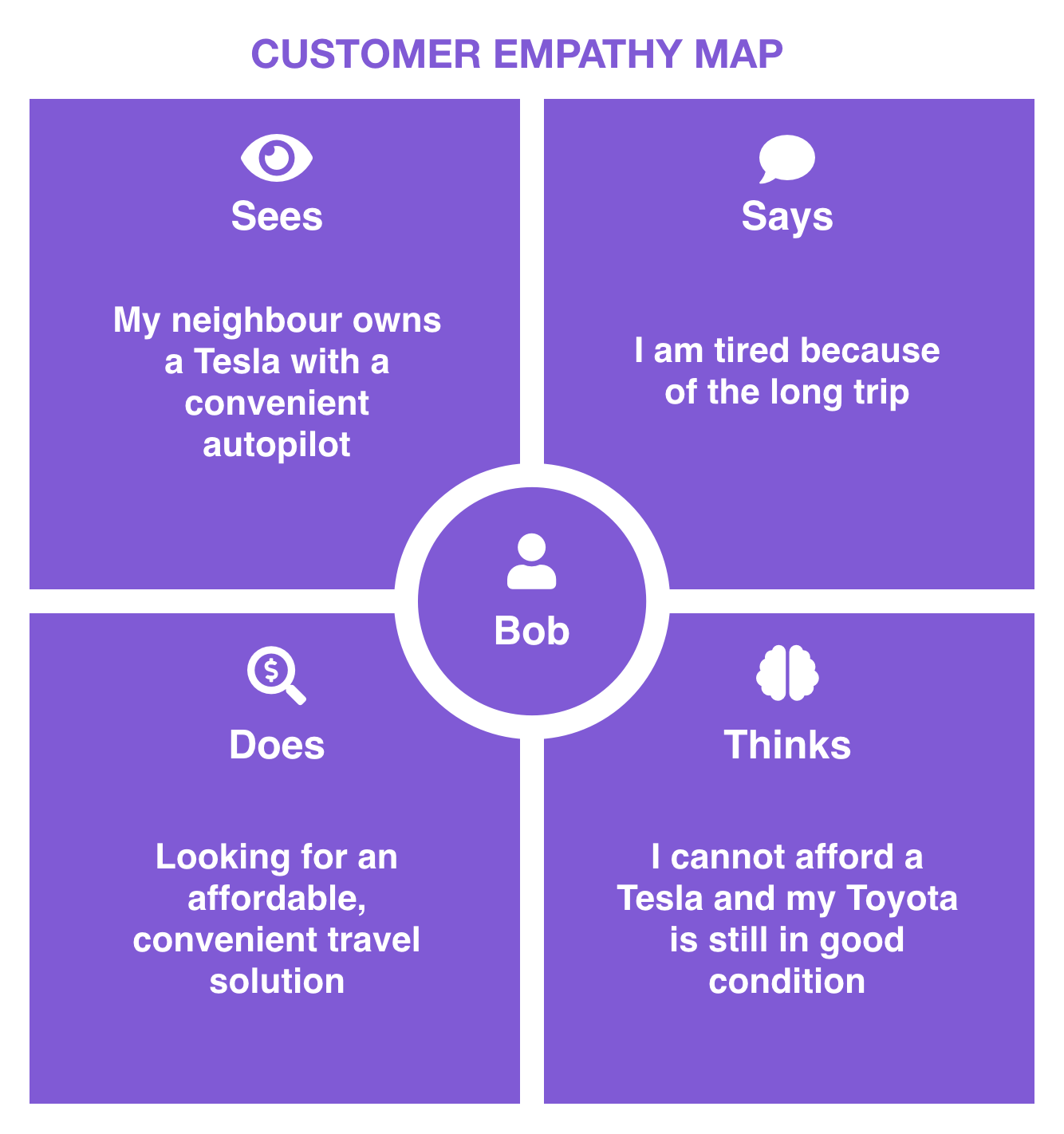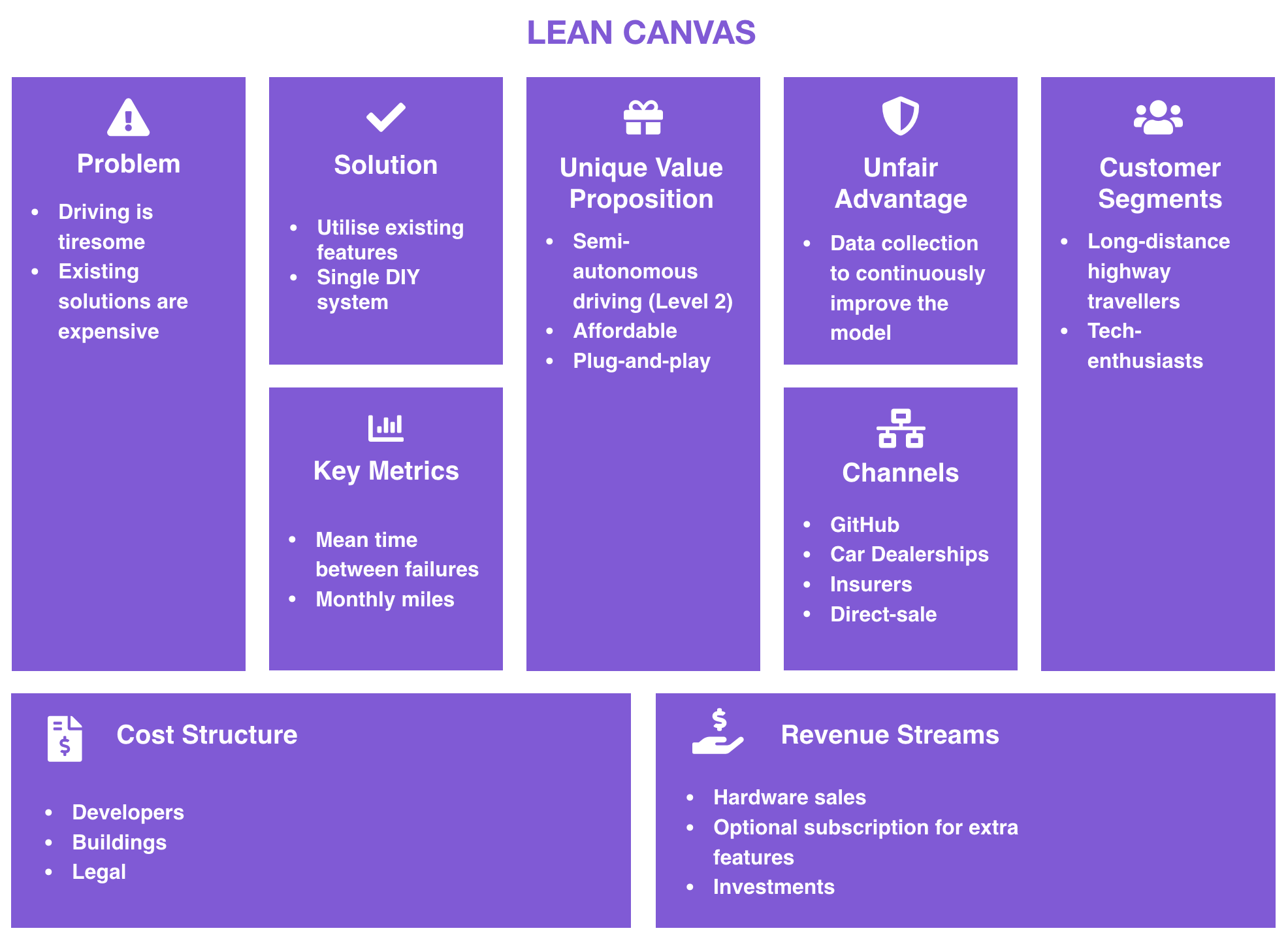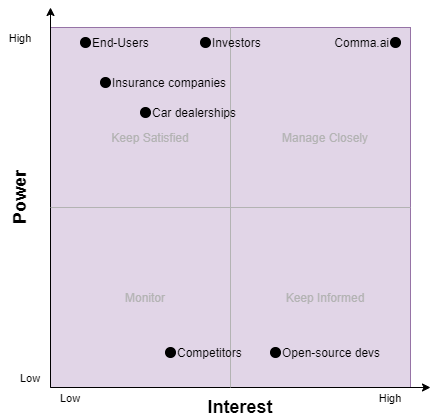Problem Definition
Bob’s Traveling Problem
The advertising slogan of openpilot is ‘make driving chill’, indicating that apparently driving is currently not so chill. Imagine Bob who’s living in the US, he visits his family on a regular basis and therefore travels between his residence in Austin TX and his family in Houston TX. Public transport is rarely available along this 266 km route, and while taking a flight is the fastest way of traveling, Bob prefers saving both his wallet and the environment by utilizing his car.
He owns a lava-red Toyota Rav4 2016, which was a serious investment for him at the time. Apart from the tough appearance and proven Japanese quality, the convenient lane departure warning (LDW) and adaptive cruise control (ACC) features were decisive in his buying decision. While these features indeed eased his driving experience, the 2,5 hour drive is still a monotone and tiresome task. To better understand Bob’s situation, consider his customer empathy map:

George’s $1000 DIY Solution
George Hotz, known for sim-unlocking the first generation iPhone and jailbreaking the Playstation 3, observed Bob’s problem in 2015 and founded Comma.ai. He considered the current status of the self-driving car industry:
- Tesla has decent driving assistance, however they are not affordable.
- Existing cars offer LDW and ACC only in isolation.
- Fully autonomous solutions like Waymo require ultra-high definition maps of the environment and multiple expensive lidar sensors.
Considering that fully autonomous car-to-car communication solutions are likely not replacing humans in the near future he proposed a DIY solution. This solution is a $1000 device mounted on the car dashboard, combining the existing features and a camera to take control. The business model consists of selling the hardware, keeping the software open-source. The Lean Canvas provides an overview of openpilot in context.

Making Driving Chill: The Requirements
Lean Architecture divides a system into two parts: What the system is (the platform) and what the system does (the end-user’s view of the system). Here, we will focus on the latter.
In the self-driving car world, there exists 6 levels of automation:
- no automation
- driver assistance
- partial automation,
- conditional automation
- high automation
- full automation
Levels 0 to 2 require full drivers attention. From level 3 onward the driver is able to take his eyes off the road.
At the time of writing, openpilot integrates four essential capabilities: ALC, ACC, LDC and FCW. This makes openpilot a level 2 autonomous system (the same level as Tesla’s AutoPilot), which means that it requires the driver to pay full attention, at all times.

As can be seen in the Lean Canvas, one of the key metrics for validating the openpilot system is mean time between failure (MTBF). Obtaining this metric is an intrinsic requirement for Comma.ai. Comma.ai’s solution to obtaining these statistics is also one of the fundamental capabilities of the openpilot system: crowdsourcing.
Although crowdsourcing does not affect the end-user directly, it is one of the pillars of the openpilot system for it allows Comma.ai to generate useful statistics and improve their machine learning training data. Each openpilot system therefore periodically uploads anonymized driver data to Comma.ai’s servers (although, since it is an open-source system, this can be disabled).
Who’s Along The Road?
The most important pawn when looking at openpilot is of course the company behind it, Comma.ai. As the main driver behind the product, Comma.ai has a lot of power, as they make the decisions on which car to make compatible, or which feature to integrate into the system next. As the product started out as an idea of the eventual founder of the company, you can imagine how passionate about, and thus interested in, improving the current state of autonomous driving they are.
This brings us back to Bob, or more generally speaking, the end-users of openpilot. Openpilot provides them with a cheap alternative to for example buying a Tesla, in order to create a better and more chill autonomous driving experience. Therefore end-users hold a lot of power, if they do not buy the product, the company will eventually go bankrupt. These end-users are not the only ones wanting to buy the product, car dealerships have also shown some interest in buying and reselling it. They would for example be able to buy the product in bunches of $750 apiece and resell them for $1200 to costumers. Due to the software being open-source, there has also been shown interest from the open-source community to work on the software. This helps them improve as a developer and might gain them some recognition in return.
The product has proven to have a better autonomous driving experience through the integration of LDW and ACC that are provided with the car, therefore making the car safer. This will not only benefit the users, but also the insurance companies, because this will lead to less accidents and thus less insurance to pay out, giving these insurance companies a lot of power. However there has not been a lot of interest from insurance companies, as it is not yet economically viable from their perspective.
Due to the growth of the product, Comma.ai has gotten interest from investors, leading to two investments so far. By buying shares of the company, the investors are able to make profit of the investment when the company’s worth grows. In the case of the company growing and an increasing amount of people using openpilot, it can have both a negative effect, reducing sales, as a positive effect, more potential customers due to the increasing market, on competing companies like Tesla and Waymo. Thus these competing companies have an interest in keeping up with the product.
To get an overview of all the stakeholders, consider the Power-Interest matrix below:

A Thing On Journey Versus Destination
At comma.ai, the journey and eventual destination show a high degree of interrelatedness. Contrary to popular belief, the journey matters as much as the destination. As an analogy, take the journey as the current context and the destination as the future context. Using a SOAR analysis, we can differentiate between the internal and external aspects of the journey (Strengths and Opportunities), and between the internal and external aspects of the destination (Aspiration and Results).

The Journey
In a business landscape dominated by huge VC investments and marketing campaigns, Comma.ai is not yet taken seriously. This is because their financial numbers and business size do not express reasons to do so. However, progression at Comma.ai is measured in terms of quality. With a very affordable product and increasing functionalities such as real time connection with the network and a driving history, the goals of comma.ai do not include obtianing a billion dollars investment. Instead they care about demonstrating safety and offering this globally. The fact that since it is a profiable company since january 2020, helps them to continue their journey.
The Destination
When you have built a system that is too good to deny, business is good. This however is a consequence, the cause is ground-breaking technology. And that technology can only become that good if users teach it how to be good. When public confidence in autonomous driving has reached satisfiable levels, the destination is close. When the MTBF of autonomous driving outperforms that of human driving, driving is chill.
Note: Diagrams created by us. Icons used originate from FontAwesome.